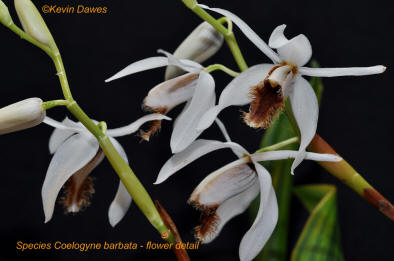Coelogyne barbata
My Coelogyne barbata finally flowered! I have owned it for several years and although it has produced spikes they have been reluctant to mature fully and produce flowers. Even when grown well the spikes take a long time to develop. I have read claims that it produces up to twenty flowers per spike. However, the flowers are produced in sequential groups of about four or five at a time as shown in the above images.
After all the waiting, I felt a bit disappointed with the result. The mass of milk chocolate brown colouring on the lip contrasted against a dull white is nowhere near as impressive as some of the other 'white' Coelogynes. The whiskers on the lip give the plant its name and these add a point of interest That makes this an interesting Coelogyne for a collector.
Coelogyne barbata has been cultivated from very early times but it is rare in collections. Perhaps this is because it is so reluctant to flower freely. Its name refers to the hairy beard on the lip.
It is generally described as an intermediate to cool growing orchid and it comes from Khasia in northeast India, Nepal, Upper Burma and surrounding areas at around 1500 metres where it grows on trees and sometimes on rocks
Cultivation Suggestions:
I have heard complaints from other growers about it being reluctant to flower. I have moved mine to different locations and it still misbehaves. The first year it successfully flowered I had moved it out of a heated glasshouse into a reasonably well insulated glass house and hung it in a wire basket near the roof. Its new location is several degrees colder (but still no frost) in winter, a few degrees warmer in summer and the plant gets much more light.
If a plant refuses to flower, a good strategy is to relocate it for a year. Often this produces results. If not, throw it away and replace it with something that likes you better. There are some orchids that simple refuse to cooperate. In this short life you want orchids that will reward you, not give you stress! However, don't give it (or worse, sell it) to a new grower and dump stress onto them. A good suggestion is to talk a friend into trying it and you will find it amazing how often it will perform well in their different environment!
Negatives: It lacks robustness and is reluctant to flower. If your collection is small and/or space limited then stay with the proven 'whites', e.g. Coel mooreana, cristata, Unchained Melody. As an aside, I have been contacted by a grower whose Coel barbata flowers beautifully and reliably in Sydney NSW. This is a common contradiction with all orchid species. If your orchid defies the general trend then really appreciate both it and your skills!
Rating: ♦♦♦ If it flowers for you then you have an interesting orchid. Please remember that my opinion is just that. Its purpose, however, is to give you an important base line from which to make evaluations of your own. There are always exceptions and the old saying that 'Beauty is in the eye of the beholder' is always true.
Sometimes sold as:
Varieties: None known
Hybrids: I have an unregistered plant from The Hanging Gardens (Australia) using Coel ovalis as pod parent. It hasn't flowered but the growth habit is very dominated by the Coel ovalis parentage. These flower at the same time, hence the above hybrid.
| < Coel assamica | Coel bilamellata > |

